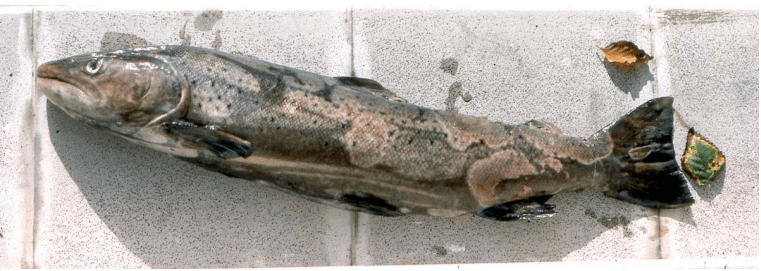
As the global human population continues to grow, secure access to nutritious food is most important for a sustainable society and its development. Fish and fishery products play a critical role in food security, contributing to the nutritional needs of people around the world. The aquaculture industry is becoming increasingly more important, as reflected by the rise in food fish consumption from 9.0 kg per capita in 1961 to 20.3 kg in 2015 (FAO, 2018). While the sustainability of ocean fishing can be debated, the scale of deliberate fish farming has risen enormously.
Global aquaculture production peaked at around 171 million metric tons in 2016, with aquaculture representing about 47% of the total production (FAO, 2018). Aquaculture and the broader fishery industry continues to grow at an annual growth rate of 5.8 %, which is faster than the growth of other major food production sectors. Fish and fish products are among the most traded food items in the world, and aquaculture holds great economic and social importance as the industry is globally distributed, supporting the livelihoods of many millions of people around the world.
As in traditional agriculture, the control of product loss to pests is crucial in a fish farm. Diseases caused by various bacteria, fungi, sea lice, and water molds (fungal-like oomycetes) are some of the most serious threats to aquaculture. Of particular concern are oomycetes of the Saprolegnia genus, which includes pathogens of fish, amphibians, crustaceans, and insects. These microorganisms are responsible for major environmental damage and financial loss in agriculture and aquaculture. Infection from Saprolegnia causes at least 10-30 % of the annual economic loss in farming of salmonid. In some instances, losses due to Saprolegnia can be as high as 50 % of the total annual loss in fish production (Van Den Berg et al., 2013). The species Saprolegnia parasitica causes saprolegniasis, an infamous disease that affects fish eggs, juveniles, and adult fish worldwide (Fig. 1).
Saprolegnia species are likely present in all freshwater ecosystems and may be partly responsible for the global decline in fish stocks, although disease rates are much higher in farmed fish. Being an opportunistic pathogen, S. parasitica infection in fish is established when an animal is subjected to physical injury, stress, or other diseases, all conditions that are exacerbated in densely populated fisheries. Once established, the infection causes damage to the integrity of the epithelium and severe tissue destruction, leading to the death of the animal. Complicating matters further is the stress caused to fish by common vaccination programs that target bacterial and viral pathogens. In the weeks following vaccination, the fish are likely to experience elevated stress and tissue damage, which increases the risk of developing saprolegniasis.
Until 2002, the organic dye malachite green was effectively used to keep the S. parasitica population under control and reduce disease incidence, but this chemical was banned for use in the fish industry due to its carcinogenic and toxicological properties. This has contributed to a resurgence of Saprolegnia infections globally.
Various other chemicals are being tested for their potential to control Saprolegnia infection, including formalin, bronopol, boric acid, dioscin, copper sulfate, and many more (Shin et al., 2017). Many of these compounds carry a similar ecotoxicity burden to malachite green. There is currently no environmentally safe and effective treatment that provides sufficient protection against the disease. New approaches to controlling oomycete growth must be developed, and these must be highly targeted in order to reduce their overall toxicity burden. To achieve this goal, it is necessary to understand the molecular and physiological pathways associated with the development, pathogenicity and host specificity of pathogens like S. parasitica.
Recently, our laboratory has presented a comparative proteomic analysis involving four developmental stages of Saprolegnia (Srivastava et al., 2018). We have now developed a working bioinformatics pipeline that combines these proteomic data with genome searches and scans of drug compound databases. This highly focused approach has led to the identification of compounds that target several candidate proteins potentially involved in vegetative growth and infection processes, which we predict will not have cross-toxicity for humans. We are currently analyzing the activity of these inhibitors on their target proteins, using both in vitro and in vivo approaches.
The identification and characterization of key target proteins have a high potential for the development of specific and environmentally friendly new anti-oomycete drugs. With a successful initial screening and testing of drugs under in vitro conditions, we have discovered several leads for potentially safe and effective disease control. Understanding the roles of target proteins in pathophysiology, infection pathways or for the survival of the pathogen, and combining this with knowledge of the mechanisms of action of potential drugs, are major activities in our laboratory.
By protecting fish for food security, our research also contributes to the United Nations Sustainable Development Goals of Zero Hunger and Life Below Water.
REFERENCES:
- FAO (2018). The State of World Fisheries and Aquaculture 2018 – Meeting the sustainable development goals. Licence: CC BY-NC-SA 3.0 IGO.: Food and Agriculture Organization of the United Nations.
- Shin, S., Kulatunga, D.C.M., Dananjaya, S.H.S., Nikapitiya, C., Lee, J., and De Zoysa, M. (2017). Saprolegnia parasitica isolated from rainbow trout in Korea: characterization, anti-saprolegnia activity and host pathogen interaction in zebrafish disease model. Mycobiology 45, 297-311.
- Srivastava, V., Rezinciuc, S., and Bulone, V. (2018). Quantitative proteomic analysis of four developmental stages of Saprolegnia parasitica. Frontiers in microbiology 8, 2658.
- Van Den Berg, A.H., McLaggan, D., Diéguez-Uribeondo, J., and Van West, P. (2013). The impact of the water moulds Saprolegnia diclina and Saprolegnia parasitica on natural ecosystems and the aquaculture industry. Fungal Biology Reviews 27, 33-42.









